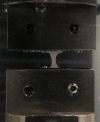Comparison of the Trueness of Fits of the Biphasic Transverse Isotropic and Kelvin Models to the Tensile Behavior of Temporomandibular Joint Disc
- PMID: 33537697
- PMCID: PMC8086185
- DOI: 10.1115/1.4050033
Comparison of the Trueness of Fits of the Biphasic Transverse Isotropic and Kelvin Models to the Tensile Behavior of Temporomandibular Joint Disc
Abstract
This technical brief explores the validity and trueness of fit for using the transverse isotropic biphasic and Kelvin models (first and second order generalized) for characterization of the viscoelastic tensile properties of the temporomandibular joint (TMJ) discs from pigs and goats at a strain rate of 10 mm/min. We performed incremental stress-relaxation tests from 0 to 12% strain, in 4% strain steps on pig TMJ disc samples. In addition, to compare the outcomes of these models between species, we also performed a single-step stress-relaxation test of 10% strain. The transverse isotropic biphasic model yielded reliable fits in reference to the least root mean squared error method only at low strain, while the Kelvin models yielded good fits at both low and high strain, with the second order generalized Kelvin model yielding the best fit. When comparing pig to goat TMJ disc in 10% strain stress-relaxation test, unlike the other two Kelvin models, the transverse isotropic model did not fit well for this larger step. In conclusion, the second order Kelvin model showed the best fits to the experimental data of both species. The transverse isotropic biphasic model did not fit well with the experimental data, although better at low strain, suggesting that the assumption of water flow only applies while uncrimping the collagen fibers. Thus, it is likely that the permeability from the biphasic model is not truly representative, and other biphasic models, such as the poroviscoelastic model, would likely yield more meaningful outputs and should be explored in future works.
Copyright © 2021 by ASME.
Figures





References
-
- Arzi, B. , Murphy, M. K. , Leale, D. M. , Vapniarsky-Arzi, N. , and Verstraete, F. J. , 2015, “ The Temporomandibular Joint of California Sea Lions (Zalophus Californianus): Part 1—Characterisation in Health and Disease,” Arch. Oral. Biol., 60(1), pp. 208–215.10.1016/j.archoralbio.2014.09.004 - DOI - PubMed
Publication types
MeSH terms
Grants and funding
LinkOut - more resources
Full Text Sources
Other Literature Sources

